Interview with Chris a Bitsend core developer. In this interview, Chirs explains what is Bitsend, where it comes from and what are the plans for the future. There are many interesting nuggets of info which Chris shares about x11, masternodes and the Segwit implementation.
Can you introduce yourself?
I’m Chris. I’ve been the developer of Bitsend for about two years now. I’ve been a crypto enthusiast since 2013 and I have been a standalone ‘street developer’ for about 15 years now.
What is the background to the BitSend story?
The coin has arisen from dust. Initially, it was called LimecoinX, abandoned by its developer. I’m the second developer of said project, which was later renamed to BitSend. In the meantime, we have gained several partner projects (e.g. IOC coinstorm, ERC Europecoin, DMD Diamond, Machinecoin).
Can you explain in more detail what do you mean by “partner projects”?
Our teams have been working hand in hand for more than half a year. We share various resources, such as technical core development, consulting and networking. That’s all that I can reveal for now.
What are the basics of this coin? (Algo, total coins, current coins, emission rate, block speed):
- Algorithm: Xevan
- Coin supply total: 210 Million
- Current coins: ~14.6 Million
- Emission rate: 33 years of mining (~4.3m per year)
- Block speed: 3 minutes
- Retarget Algo: DK3 with Diffbreak
The goal of the coin is a long-term and fair rollout. It should be open for current and upcoming generations.
When and how did Bitsend start?
The project started as LIMX coin back in the middle of 2014. It was later taken over and renamed by myself and the team.
Was there a pre-mine, instamine or similar for this project?
The original coin had about ~1.3 million premined coins. These coins do not exist anymore and were never available to me either.
The Bitsend price has recently seen a spike, is there any specific news that you can attribute to this?
We did welcome a few new team members in addition to rolling out a few services and doing some updates. BSD BitSend did by the DASH price spike get attention as an alternative with still low entry cost and similar abilities without a budgetary Masternode tax.
What are the requirements to host a node?
A static IP address, and quite low system requirements (1 CPU, 512 MB RAM, 5 GB HDD). A VPS with more resources can even host multiple masternodes.
Do you foresee any changes to these requirements in the future?
With the growth of the network, the storage keep growing naturally beside that it will stay relative constant.
What do you mean by Storage keep?
What was meant is that the storage requirements are going to grow naturally, with user adoption (i.e. organic growth). The maximum of the growth rate is restricted by the maximum block size limit (currently 10 MB). Due to advances in technology, we do not see this becoming an issue in the near-term future.

What are the weakest points of masternodes?
There are several weaknesses when it comes to nodes. One of the primary concerns would be (D)DoS attacks, packet sniffing and similar. The beneficial factor of masternodes is that they are much more Sybil attack resistant than the classic nodes (as, e.g., found in Bitcoin). The big counter against any possible VPS security issues is that you don’t have to provide a private key with access to the coins on a masternode which is started from a remote control wallet. Basically, the Controlwallet with real coin access can go offline and your coins are full in secure mode after start the masternodes.
Is there a turnkey provider for hosting for nodes?
There is no provider for BitSend nodes yet, but this is a great business opportunity sure not long without service providers.
Do you have any suggested services to host nodes?
We are always happy to directly assist users via our Slack channel. Guides to set up and run Nodes on own cheap VPS are existing and are constantly improved to even allow people new to create nodes.
What is the role of master nodes for BitSend?
Masternodes in Bitsend do not have a governance system, but they have a voting system. They are important for the Network, Darksend and Instantsend and can be utilised in new services in the future.
What percentage of block rewards goes into the treasury system?
Currently, there is no percentage that goes into the treasury. 20% goes to the miners, and 80% to the masternodes.
Does the coin have or plan to have a budgetary system similar to Dash?
The coin does not have such a system, and currently, there are no plans to add it either. In the case that the user desire some sort of budgetary system, then we would probably consider adding one.
How will BitSend sustain itself in the long-term?
Our objective is to ensure a fairly good and extensive distribution, which is one of the reasons for which we’ve decided to do our airdrop. I find that very important for the long-term success of a coin. Due to this, it is more likely that a greater number of users and therefore also a greater number of developers are going to get attracted to the project.
What kind of proposals is the community looking for?
We’ve recently been running some polls. It seems that there is strong demand for Bitcoin Core 0.14.0 (Segwit) codebase, SPV wallets and gambling websites.
What are the main strengths and weakness of masternodes in cryptocurrencies?
The benefit is Proof of Service for the network. They allow different kind of features to be implemented such as the mentioned governance system, which wouldn’t work with the traditional nodes. There are some concerns that masternodes could be points of deanonymization. In addition to that, a lot of the masternodes are usually hosted on VPS’es (which means that they could be implanted with malware).
Which ones are you most likely to implement? Do you have a timeline?
Bitcoin Core 0.14.0 (Segwit) is already being worked on. We do not favour timelines or the classic (often used by both genuine and scam ICOs) “roadmaps”. We would like to focus on actually implementing, testing and safely deploying software rather than pushing for deadlines. We also encourage the community members to contribute in building the infrastructure by offering bounties.
How many developers are working on BitSend?
There are 5 developers who are constantly working in Bitsend.
How is the team of coders and marketers paid?
Currently, the team members are primarily contributing to the project because they believe in the vision behind it and its potential. However, the team is both actively mining and hosting masternodes on the network. The Bitsend generated through these methods is then used to pay members for their contributions and other expenses (e.g. marketing); we have a substantial amount of Bitcoin, which is also often used for payments.
Even if there is no premine, the existing the core team members did gather a sufficient amount of BSD in order to pay the airdrop and bounties for freelancers with MN income thereby playing by the same rules as any other investor who runs a MN. Everyone involved is a major stakeholder and therefore has an incentive to work towards the success of their investment.
Is there a dedicated marketing team?
Yes. We have Steve (also known as, metamorphin), Jon (darkjon) and Lauda who is a new addition to the team. We often get help from many enthusiasts of different coins who wanna see BitSend succeed too.
What are the next key steps for the coin? Where do you see the coin in three years time?
BitSend is already a long term project. There is a lot in the pipeline. Development wise, as mentioned above, the key step is updating the code to Bitcoin Core 0.14.0 and activating Segwit (planned for Q1/2018). This will enable BitSend to also easily add various technologies, such as the Lightning Network, Tumblebit, Mimblewimble, Sidechains. Aside from that, we are generally looking to expanding the existing infrastructure. This means that we plan on rolling out or providing incentives for others to roll out various missing services. One of the things that you are probably going to notice very soon is a redesigned website and ANN thread.
How will Segwit benefit the users in practice?
The main client will be updated to Segwit, therefore the latest release for the nodes would have it integrated. Bitcoin Core has written an extensive post about the benefits of Segwit: https://bitcoincore.org/en/2016/01/26/segwit-benefits/ I’ve also outlined what it would enable in the answer above. Each one of those has its own benefits (the technologies are far too extensive to describe within this answer).
For more information on Bitsend visit:
Website: http://www.bitsend.info/
Twitter: https://twitter.com/it_send
BitcoinTalk: https://bitcointalk.org/index.php?topic=1370307.0
Slack: https://bitsend.slack.com/
We thank Chris for the interview.












